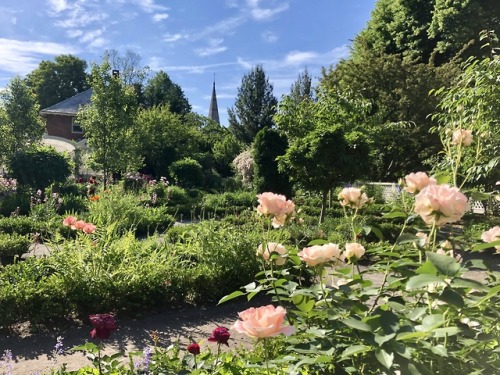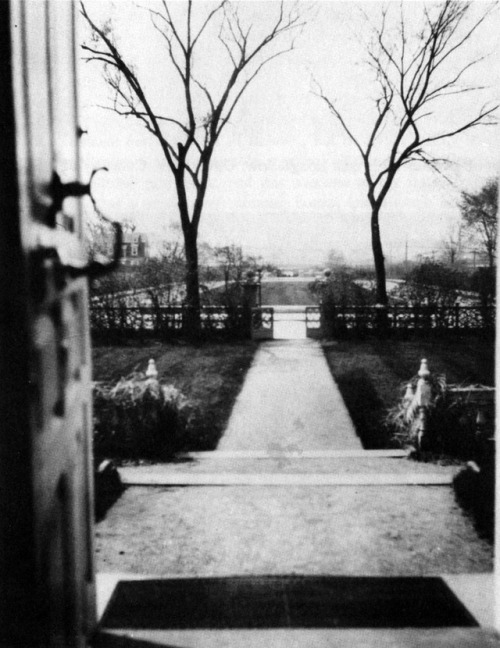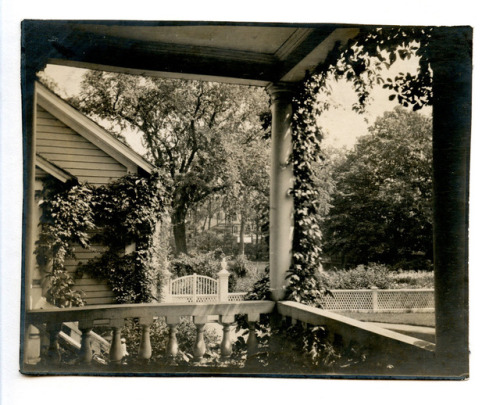#washington slept here
Landscapes of Literature: Henry Wadsworth Longfellow
Tucked away in a pleasant, residential neighborhood, not too far away from Harvard University in Cambridge, Massachusetts, is Longfellow House-Washington’s Headquarters National Historic Site.

Each spring, lilacs bloom on the hedges surrounding Longfellow House-Washington’s Headquarters National Historic Site (NPS).
This site preserves an elegant house which served as headquarters for General George Washington during the Siege of Boston and as the home of Henry Wadsworth Longfellow (1807 -1882), one of the most famous American poets of the 1800s. For 45 years, Longfellow lived here with his family in the Georgian style mansion, looking out upon picturesque estate grounds that included a formal garden, woodland walk, lilacs, elm trees at the front of the house, a view to the Charles River, and outbuildings like the carriage house.
River! that in silence windest
Through the meadows, bright and free,
Till at length thy rest thou findest
In the bosom of the sea!
Four long years of mingled feeling,
Half in rest, and half in strife,
I have seen thy waters stealing
Onward, like the stream of life.
Thou hast taught me, Silent River!
Many a lesson, deep and long;
Thou hast been a generous giver;
I can give thee but a song.
Oft in sadness and in illness,
I have watched thy current glide,
Till the beauty of its stillness
Overflowed me, like a tide.
– excerpt from “To the River Charles” by Henry Wadsworth Longfellow, in Ballads and Other Poems(1842)
While in residence, he published eleven poetry collections, two novels, several plays, three epic poems, including Paul Revere’s Ride,The Village Blacksmith,Evangeline,The Song of Hiawatha, and notable translations such as Dante Alighieri’s Divine Comedy.
The Formal Garden
Longfellow and his daughter, Alice, shared an interest in landscape architecture, represented by the formal grounds, including a garden on the northeast end of the property which they carefully designed over time. Longfellow imported a variety of exotic evergreen trees from as far as the Himalayas, Northern Europe, and Oregon with help from renowned botanist Asa Gray.
In 1847, he sought the assistance of landscape architect Richard Dolben to create a new designed garden. Following Longfellow’s death, the formal garden was renovated by his daughter to its current Colonial Revival layout in 1904-05 and 1925.
In 2005-06, the garden was restored based on historical documentation in the site’s archives, largely based on the earlier 1925 rehabilitation by noted landscape architect Ellen Shipman. A large European linden stands in the east lawn toward the rear of the house, where this garden remains on the footprint of the original 1847 design.
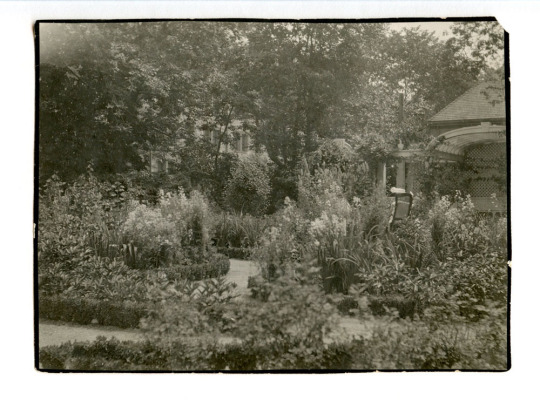
Formal garden, looking northwest toward arbor. Wheelchair is visible in garden with occupant (possibly Alice Longfellow, 1888-1928), ca. 1904-C1928. The arbor was added by Martha Brookes Hutcheson (1904) and removed (1932/34). (National Park Service / Longfellow House Washington’s Headquarters, LONG 7503).
Expressions
From the time that he first starting renting two rooms on the house’s second floor, the letters and journals of Henry Wadsworth Longfellow expressed that the history and character of the grounds were a source of both pleasure and inspiration for him.
In one journal entry, he writes, “How glorious these Spring mornings are! I sit by an open window and inhale the pure morning air, and feel how delightful it is to live! Peach, pear and cherry trees are all in blossom together in the garden.” [1]
Later, in an 1843 letter to his father, Longfellow described the past and future of the landscape:
We have purchased a mansion here, built before the Revolution, and occupied by Washington as his Headquarters when the American Army was at Cambridge. It is a fine old house and I have a strong attachment from having lived in it since I first came to Cambridge. With it are five acres of land. The Charles River winds through the meadows in front and in the rear I yesterday planted an avenue of Linden trees, which already begin to be ten or twelve feet high. I have also planted some acorns and the oaks grow for a thousand years, you may imagine a whole line of little Longfellows, like the shadowy monarchs of Macbeth, walking under their branches for countless generations, “to the crack of doom,” all blessing the men who planted the oaks.[2]
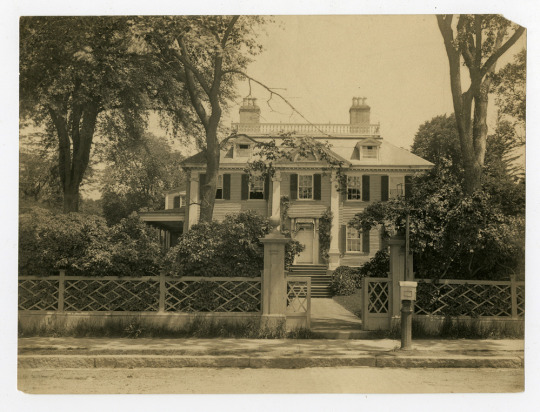
South facade of Longfellow House taken from outside fence on Brattle Street, 1910 (National Park Service, Longfellow House-Washington’s Headquarters, Archives Number: 3008-1-1-17).
Longfellow Summer Festival
If you find yourself in Cambridge on a summer day, celebrate the history of the cultural landscape and contemporary poets and creators at the annual Longfellow Summer Festival. The festival, a tradition nearly as old as the park itself, brings music and poetry alive at the Longfellow House on Sunday afternoons through August.
- For the schedule of upcoming events: 2019 Summer Festival
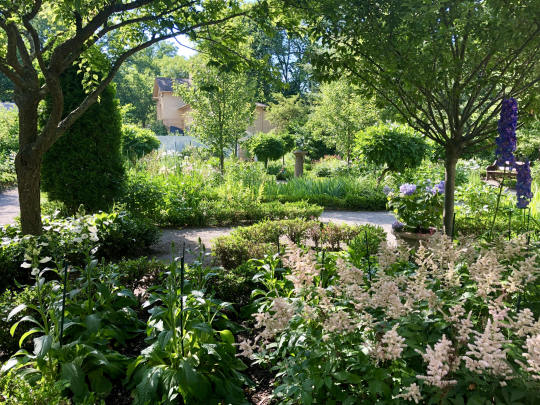
Garden in bloom at Longfellow House - Washington’s Headquarters NHS (NPS).
Learn More
- Longfellow House - Washington’s Headquarters National Historic Site Digital Archive
- Longfellow House - Washington’s Headquarters Landscape Cultural Landscape Inventory
- Cultural Landscape Report: Longfellow National Historic Site, Volume 1, Site History and Existing Conditions
- Cultural Landscape Report: Longfellow National Historic Site, Volume 2, Analysis of Significance and Integrity
- Plan Your Trip: Longfellow House - Washington’s Headquarters National Historic Site park website
- What are cultural landscapes?
*Thanks to the Longfellow House - Washington’s Headquarters NHS and others for help preparing this story!*
[1]Henry Wadsworth Longfellow Journals, Cambridge, May 20, 1838, Houghton Library, Harvard University, Cambridge, as cited by Evans in Cultural Landscape Report for Longfellow National Historic Site, Volume 1: Site History and Existing Conditions, 1993, 33.
[2] Henry Wadsworth Longfellow to Ferdinand Freiligrath, November 24, 1843, as cited by Luzader in Historic Structures Report, Longfellow House: Historical Data, 1974, 23.
Post link

